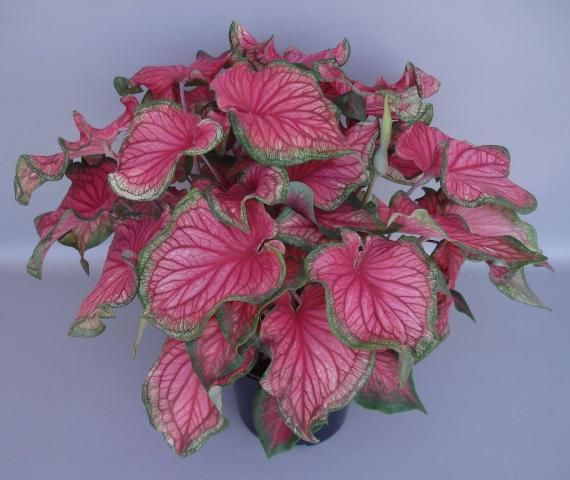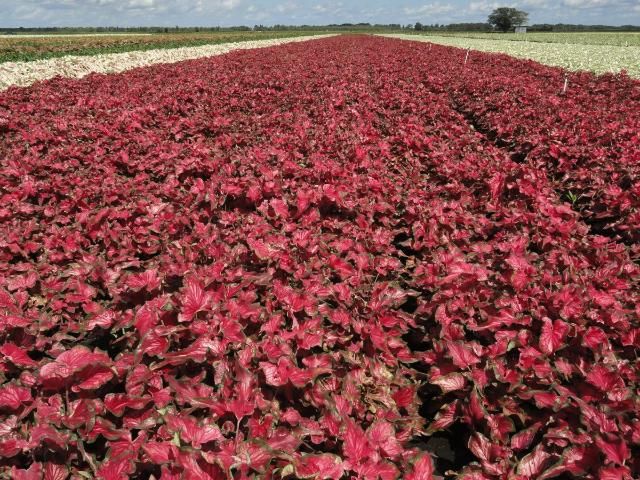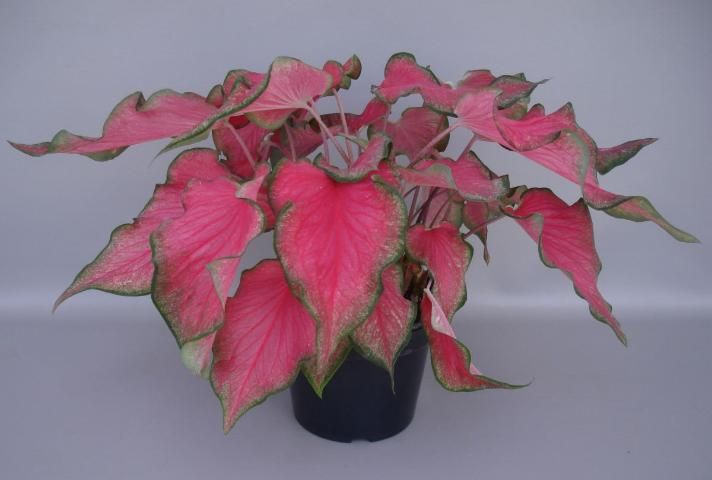Caladium cultivars are generally grouped into either the fancy- or the lance-leaved type. Plants of lance-leaved caladiums tend to be more compact, with smaller leaves and shorter petioles than fancy-leaved caladiums. Tubers produced by lance-leaved caladiums are usually more branched than tubers from fancy-leaved cultivars and do not need de-eying prior to pot plant production. Lance-leaved caladium plants also tend to be more adaptable to different container sizes and easier to ship from production sites to markets. Lance-leaved caladiums appear to be more resilient to wind damages, droughts, sun, and shading than fancy-leaved caladiums, and they may perform better than fancy-leaved caladiums in the landscape when such stresses occur. However, many lance-leaved cultivars often produce small tubers, making it difficult for growers to produce tubers profitably. Developing new lance-leaved caladium cultivars with adequate tuber yield potential has been a priority breeding objective. Currently, 'Florida Sweetheart' is the most widely grown lance-leaved commercial cultivar of any color, and 'Florida Red Ruffles' is the most widely grown red lance-leaved commercial cultivar. Plants of 'Florida Sweetheart' are compact and produce wide lance leaves with a rosy color as well as relatively large tubers. 'Florida Red Ruffles' has a compact, upright growth habit and excellent sun tolerance.
Leaves of 'Sizzle' are characterized by thick, dark red to purple veins and a dark red to purple overtone. This cultivar has shown improved tuber yield potential over 'Florida Sweetheart' and 'Florida Red Ruffles', produced high-quality pot plants, and performed very well in the landscape with excellent sun tolerance. 'Passionista' has an overall plant growth habit similar to that of 'Florida Red Ruffles', but it is distinct from 'Florida Red Ruffles' with its bright pink leaves and higher tuber yield potential. The availability of 'Sizzle' and 'Passionista' may expand the color palette for caladium plants desired by greenhouse growers, nurseries, and gardeners.

Credit: Gail Bowman, UF/IFAS

Credit: Zhanao Deng, UF/IFAS

Credit: Gail Bowman, UF/IFAS
Plant Description
'Sizzle': Plants (approximately 1.5 months old) have an average height of 14.4 in. Leaves average out to 7.9 in × 6.3 in (length × width) and are ovate with a cordate base, an acuminate to acute apex, an entire and slightly undulate margin, and two basal lobes. On the upper leaf surface, a green margin, up to 0.4 in wide, borders the entire leaf. The leaf center is red. Venation pattern is pinnate, with as many as 16 grayed-purple veins radiating from a central red vein. Secondary and tertiary veins tend to be netted across the entire leaf. Small blotches of green and/or numerous specks of white may appear along the margin and between primary veins. The leaf undersurface has a grayed-green margin up to 0.8 in wide, a red center, a grayed-red midrib vein, and several green primary veins. Irregular yellow-white mottling is present from the margin into the center area. Petioles are mostly erect, curving outwardly with development. They tend to be light brown with long, dark brown streaks or speckles from the apex to the base of the petioles. Jumbo tubers are multisegmented, bearing six to nine dominant buds. Tuber surfaces are brown with a yellow cortical area.
'Passionista': Plants (approximately 1.5 months old) have an average height of 13 in. Leaves have average dimensions of 9.4 in × 6.2 in (length × width). Leaves are ovate with a sagittate base, an acuminate to acute apex, and an entire and wavy margin. On the upper leaf surface, a narrow green margin, up to 0.2 in wide, borders the entire leaf. The leaf center is red. Venation pattern is pinnate, with as many as ten red veins radiating from a central red vein. Secondary and tertiary veins tend to be netted across the entire leaf. Numerous specks of white appear along margins and between primary veins. The leaf undersurface has a grayed-green margin up to 0.4 in wide in addition to a grayed-purple center, midrib veins, and primary veins. Irregular grayed-yellow and grayed-green mottling, up to 0.6 in wide, parallels the margin. Petioles are mostly erect, curving outward with development, and are mainly grayed-red with grayed-green specks running from apex to base. Yellow-green coloration may appear on the petioles. Jumbo tubers are multisegmented, bearing six to nine dominant buds. Tuber surfaces are brown, and the cortical area is yellow.
Tuber Yield Potential
'Sizzle' and 'Passionista' were evaluated for tuber yield potential at the UF/IFAS Gulf Coast Research and Education Center in Wimauma, FL, in 2007, 2008, and 2009. The soil was fine sand with about 1% organic matter and pH between 6.2 and 7.4. Caladium plants were grown in the field using a plastic-mulched raised-bed system. For the 2007 growing season, ground beds (32 in wide, 8 in high) were fumigated with a mixture of 67% methyl bromide and 33% chloropicrin (by volume) at 175 lb per acre. Caladium seed pieces (tuber pieces, approximately 1 × 1 × 1 in) were planted manually in April with approximately 1 ft of space between rows and 6 in of space within rows. Drip tapes buried under the plastic mulch delivered water to the bed. Fertigation began when young caladium plants emerged from the soil, supplying soluble fertilizer at approximately 1.7 lb of nitrogen per acre per day for a total of 259 lb of nitrogen per acre per growing season. Tubers (new crop) were harvested, washed, and dried in early January 2008. Dried tubers from each experimental field plot were weighed, graded, and counted in late January 2008. Tubers were graded by their maximum diameter: Super Mammoth (greater than 4.5 in), Mammoth (3.5 to 4.5 in), Jumbo (2.5 to 3.5 in), No. 1 (1.5 to 2.5 in), and No. 2 (1 to 1.5 in). Tuber grades and counts were converted into Production Index to show the relative economic value of the harvested tubers per field plot. For the 2008 growing season, beds were fumigated with a mixture of 80% methyl bromide and 20% chloropicrin (by volume) at 400 lb per acre. Caladium seed pieces were planted April 18th with approximately 6 in of space between and within rows. The irrigation and fertigation system was the same as the one used in 2007. Tubers were dug between December 2nd and 8th the following year, then washed, dried, weighed, graded, and counted as they were in 2007. For the 2009 growing season, beds were fumigated with a mixture of 50% methyl bromide and 50% chloropicrin (by volume) at 175 lb per acre. Caladium seed pieces were planted April 9th with approximately 6 in of space between and within rows. The irrigation and fertigation system was the same as the one used in 2007, but each plant received one teaspoon of the controlled-release fertilizer Osmocote® (15-9-12, 5 to 6 months) on July 21st. Tubers were harvested between November 30th and December 2nd, 2009, then washed, dried, weighed, graded, and counted as they were in 2007.
'Sizzle': There were no significant differences between 'Sizzle' and 'Florida Sweetheart' in tuber weight, numbers of marketable tubers, and production index in the 2007 growing season (Table 1). However, the new caladium cultivar's tuber weight and production index were 84.2% and 54.5% greater, respectively, than those of 'Florida Sweetheart' in the 2008 season. The differences between 'Sizzle' and 'Florida Sweetheart' in tuber weight, number of marketable tubers, and production index in the 2009 growing season were not significant.
Tuber weights of 'Sizzle' were 33.3% (2007), 133.3% (2008), and 177.8% (2009) greater than those of 'Florida Red Ruffles', and the production indexes of 'Sizzle' were 59.1% (2007), 67.7% (2008), and 118.4% (2009) higher than those of 'Florida Red Ruffles'.
'Sizzle' and 'Florida Sweetheart' generally shared similar tuber grade distributions, but 'Sizzle' produced more No. 1-sized tubers in 2007 (Table 1). 'Sizzle' shared similar tuber grade distributions with 'Florida Red Ruffles' in 2007 but produced larger tubers in 2008 and 2009. 'Sizzle' produced a higher percentage of Jumbo-sized tubers with a lower percentage of No. 2-sized tubers in 2008, and a higher percentage of Mammoth-sized and Jumbo-sized tubers with a lower percentage of No. 2-sized tubers in 2009.
'Passionista': There were no significant differences between 'Passionista' and 'Florida Sweetheart' in tuber weight, numbers of marketable tubers, and production index in 2007 (Table 1). 'Passionista' had a greater tuber weight and a higher production index than 'Florida Sweetheart' in 2008. In 2009, 'Passionista' and 'Florida Sweetheart' were not significantly different in tuber weight and production index, but 'Passionista' produced fewer marketable tubers than 'Florida Sweetheart'.
'Passionista' had numbers of marketable tubers comparable with those of 'Florida Red Ruffles', but its tuber weights were 59.3% (2007), 193.3% (2008), and 222.2% (2009) greater than the tuber weights of 'Florida Red Ruffles' during the same years.
'Passionista' produced more large tubers in Mammoth and Jumbo categories and fewer small tubers in the No. 2 category than both 'Florida Sweetheart' and 'Florida Red Ruffles' (Table 1). Specifically, 'Passionista' produced more No. 1-sized tubers than 'Florida Sweetheart' in 2007, and more Mammoth- and Jumbo-sized tubers than the same cultivar in 2008. The new cultivar produced more tubers in the Mammoth category and fewer No. 2-sized tubers than 'Florida Sweetheart' in 2009. 'Passionista' also produced more Mammoth- and Jumbo-sized tubers but fewer No. 2-sized tubers than 'Florida Red Ruffles' in 2008 and 2009.
Container Trials
The suitability of the two new cultivars for pot plant production was evaluated by forcing tubers into 4.5-in containers in spring 2008. No. 1 tubers were planted in a mix of peat and vermiculite on April 17th, 2008, in a greenhouse with 45% light exclusion. Plant height, plant width, number of leaves, and foliar characteristics were recorded on June 12th, 2008. Quality of the potted caladium plants was rated on a scale of 1 (very poor plants with few leaves) to 5 (very attractive, full, and symmetrical plants with many bright, colorful leaves and an appropriate height).
'Sizzle': Tubers of this new cultivar sprouted in roughly the same amount of time as 'Florida Red Ruffles' and 'Florida Sweetheart' tubers (37 days and 35 days after planting, respectively) (Table 2). Container-grown 'Sizzle' plants had heights and widths comparable with those of container-grown 'Florida Red Ruffles' and 'Florida Sweetheart' plants. 'Sizzle' plants produced approximately 61% more leaves that were about 1 in shorter and 1 to 2 in narrower than those of 'Florida Red Ruffles' and 'Florida Sweetheart', respectively. 'Sizzle', 'Florida Red Ruffles', and 'Florida Sweetheart' produced quality pot plants and received similar quality ratings (3.7 to 4.1) (Table 2).
'Passionista': Tubers sprouted about 34 days after planting in a timeframe similar to that of the 'Florida Red Ruffles' and 'Florida Sweetheart' tubers (Table 2). 'Passionista' plants had an average height of 9 in and width of 17.8 in, about 2 to 3 in taller and 4 in wider than 'Florida Red Ruffles' and 'Florida Sweetheart' plants, respectively. 'Passionista' plants produced approximately as many leaves as 'Florida Red Ruffles' and 'Florida Sweetheart' plants did, but 'Passionista' leaves were about 8.7 in long and 4.8 in wide, or 1 to 2 in longer than the 'Florida Red Ruffles' and 'Florida Sweetheart' leaves. 'Passionista' leaves were 1 in narrower than those of 'Florida Sweetheart', but they had similar widths to those of 'Florida Red Ruffles'. 'Passionista' also produced quality pot plants that received an average plant quality rating of 3.8, comparable to 'Florida Red Ruffles' and 'Florida Sweetheart' ratings, in 8 weeks.
Landscape Performance
Landscape performance of 'Sizzle' and 'Passionista' was evaluated on the same plots used for tuber production assessment, utilizing a scale of 1 (very poor plants with few leaves and lack of vigor) to 5 (excellent, full plants with numerous leaves and bright color display). Leaf sun tolerance was also scored on a scale of 1 to 5, with 1 being very susceptible to sun (numerous sun-damaged areas or holes) and 5 being resistant to sun (no visibly sun-damaged areas). Three evaluations for plant performance and sun tolerance were conducted during each growing season. Plant height, number of leaves, and leaf size were measured on three plants randomly chosen from each plot approximately 4 months after planting.
'Sizzle': This cultivar showed good to excellent plant performance when grown in ground beds in full sun. After 4 months, plants had an average height of 11 in, which was approximately 2 to 4 in taller than 'Florida Red Ruffles' or 'Florida Sweetheart' plants (Table 3). 'Sizzle' leaves had average dimensions of 8 in × 5 in (length × width). They were 1.5 in longer and 1 in wider than the leaves of 'Florida Red Ruffles', but still similar to the average size of 'Florida Sweetheart' leaves. Leaves were dark red or purple and had thick veins. Plants received acceptable to excellent plant performance ratings (3.1 to 4.7) in all evaluations during three growing seasons (Table 4). The plant performance ratings of 'Sizzle' were significantly higher than those of 'Florida Red Ruffles' or 'Florida Sweetheart' in five out of nine evaluations and similar to the ratings of the aforementioned cultivars in three to four evaluations. 'Sizzle' did not perform as well as 'Florida Sweetheart' in only one evaluation.
'Florida Red Ruffles' and 'Florida Sweetheart' are considered sun-tolerant cultivars. Their sun tolerance ratings in 2007, 2008, and 2009 ranged from 2.3 to 5.0 and from 3.2 to 4.7, respectively (Table 4). The sun tolerance ratings of 'Sizzle' were between 3.5 and 5.0, similar to or better than the sun tolerance ratings of 'Florida Sweetheart' or 'Florida Red Ruffles' in eight out of the nine evaluations. These ratings suggest excellent sun tolerance in 'Sizzle'.
'Passionista': Plants had an average height of 10.4 in, about 2 to 3 in taller than 'Florida Red Ruffles' or 'Florida Sweetheart' plants. The average leaf dimensions were 8.5 in × 4 in (length × width) (Table 3), about 1 to 2 in longer than the leaves of the commercial cultivars. Plant performance ratings of 'Passionista' ranged from 2.9 to 4.9 in nine evaluations over the course of three growing seasons between 2007 and 2009. Performance ratings were significantly higher than those of 'Florida Red Ruffles' or 'Florida Sweetheart' in four or five of the nine evaluations (2008 and 2009) (Table 4). The sun tolerance ratings of 'Passionista' were between 2.9 and 5.0, except for one evaluation in which the plant's sun tolerance rating was 1.8. Sunlight bleached out the pink color, which led to lower sun tolerance ratings.
Recommendation
'Sizzle' plants are tolerant of sunlight and can perform very well in both sunny and shady locations. In full sun, leaf color becomes even more intense and attractive. 'Sizzle' produces high-quality potted plants, even in small containers (4.5-in diameter) and without de-eyeing of tubers; thus, it is highly suitable for potted plant production in a wide range of container sizes. Tubers of this cultivar sprout several days later than 'Florida Sweetheart' tubers. If possible, growers should plan for one or two extra weeks when producing potted plants from 'Sizzle' tubers. To obtain high tuber yield, it may be necessary to plant 'Sizzle' seed in the field early and harvest the tubers late so the cultivar has a longer growing season in the field.
When grown under shade, 'Passionista' produces very attractive bright pink leaves. Direct exposure to sunlight tends to bleach the leaf color. As a result, this cultivar is best suited for shady locations. It produces high-quality pot plants in containers 4 in or larger and does not require de-eyeing. Its leaves are longer than those of 'Florida Red Ruffles' and 'Florida Sweetheart'; therefore, potted 'Passionista' plants need larger spacing in pot plant production. In field trials, 'Passionista' produced more and/or larger tubers than 'Florida Sweetheart' and 'Florida Red Ruffles'.
Although extensive research and evaluations of these cultivars have been performed on small acreages, growers are encouraged to plant only limited quantities of 'Sizzle' and 'Passionista' until they have gained experience in producing these cultivars. Standard postharvest treatment of tubers is recommended (Harbaugh and Tjia 1985), and preplant hot-water treatment of tubers (Rhodes 1964) is encouraged.
Availability
'Sizzle' and 'Passionista' were released under the names 'UF 432' and 'UF 4015', respectively (Deng et al. 2015). The UF/IFAS Florida Agricultural Experiment Station has been issued plant patents for 'Sizzle' (PP26,591) and 'Passionista' (PP26,592). Propagation and production of these cultivars require a licensing agreement with the Florida Foundation Seed Producers, Inc., PO Box 309, Greenwood, FL 32443. Information on tuber availability and propagation agreements can be obtained from the Florida Foundation Seed Producers, Inc. (http://www.ffsp.net/).
References
Deng, Z., B. K. Harbaugh, and N. A. Peres. 2015. "'UF 432' and 'UF 4015'—Two lance-leaved caladium cultivars." HortScience 50: 1099–1103.
Harbaugh, B. K., and B. O. Tjia. 1985. Commercial Forcing of Caladiums. Circ. 621. Gainesville: University of Florida Institute of Food and Agricultural Sciences.
Rhodes, H. L. 1964. "Effect of hot water treatment of seed tubers and soil fumigation for control of root knot on yield of caladiums." Plant Disease Reporter 8: 568–71.
Tables
Tuber weight, production index, and grade distribution of 'Sizzle', 'Passionista', and two commercial cultivars grown in Wimauma, FL, in 2007, 2008, and 2009. Values presented for each year are means of three plots in three randomized complete blocks; and each plot was 13 sq ft with 30 tuber propagules planted
Plant characteristics and performance of 'Sizzle', 'Passionista', and two commercial varieties grown in 4.5-in containers in a 45% shaded glasshouse in Wimauma, FL, in 2008.
Plant characteristics of 'Sizzle',' Passionista', and two commercial cultivars approximately 4 months after planting tuber propagules (approximately 1 in × 1 in × 1 in) in full sun and ground beds (sandy soil) in Wimauma, FL, in 2007, 2008, and 2009.